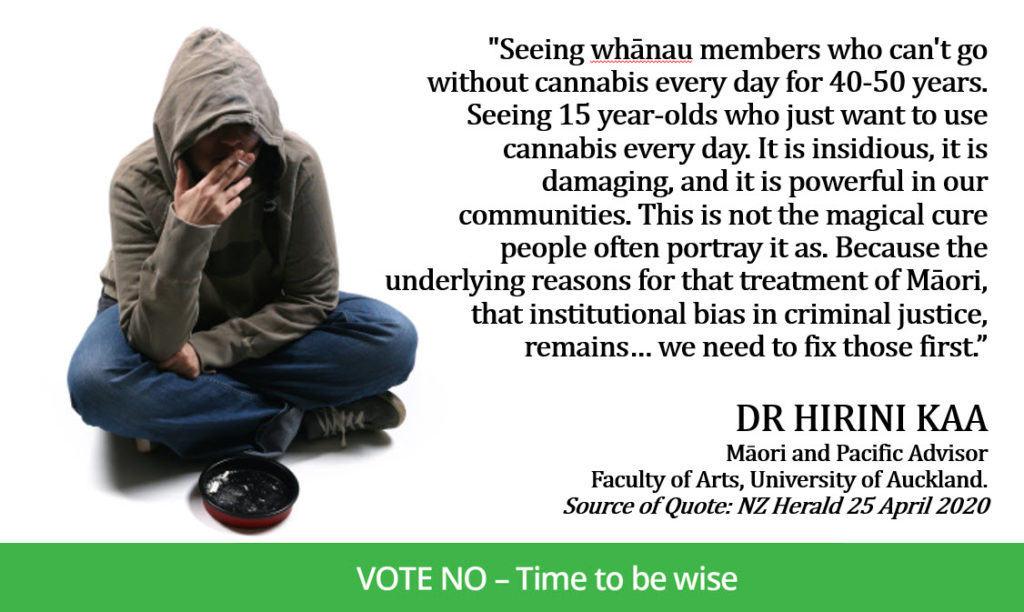
CRIMINAL OFFENCE RATES
Pro-marijuana advocates argue that legalisation will increase ‘social justice’, but if there are issues of systemic injustice and racism, the U.S. experience is showing that legalisation does not address the root of these issues and instead only exacerbates these problems by promoting increased drug use and the accompanying negative social consequences in disadvantaged communities. Disparities in drug use and criminal offence rates continue to exist between different racial and income groups in US states which have legalised.
The District of Columbia saw public consumption and distribution arrests nearly triple between the years 2015 and 2016, and a disproportionate number of those marijuana-related arrests occur among African-Americans. Colorado has seen a similar trend.
In states that have legalised marijuana, minority youth are showing much larger increases in use of marijuana than their Caucasian counterparts (Johnson, 2018). 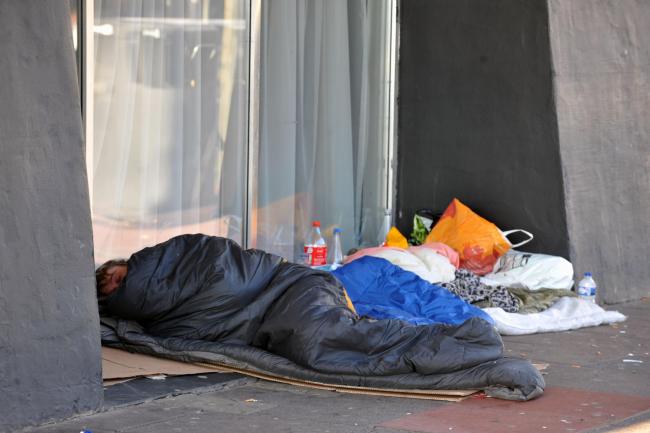 Colorado marijuana arrests for young African-American and Hispanic youth have increased since legalisation. The 2017 marijuana-related African American arrest rate in Colorado is nearly twice that of Caucasians (233 in 100,000 versus 118 in 100,000) (Colorado Department of Public Safety (2018) Impacts of Marijuana Legalization in Colorado: A Report Pursuant to Senate Bill 13-283. Division of Criminal Justice.)
Colorado marijuana arrests for young African-American and Hispanic youth have increased since legalisation. The 2017 marijuana-related African American arrest rate in Colorado is nearly twice that of Caucasians (233 in 100,000 versus 118 in 100,000) (Colorado Department of Public Safety (2018) Impacts of Marijuana Legalization in Colorado: A Report Pursuant to Senate Bill 13-283. Division of Criminal Justice.)
In Washington D.C., between 2015 and 2017 (the years immediately following legalisation), although total marijuana-related arrests have gone down, distribution and public consumption arrests more than tripled. Among adults, 89% of marijuana distribution or public consumption arrestees were African American (DC Metropolitan Policy Department, 2018)
The reason? According to a 2013 survey conducted by the Colorado Department of Public Health and Environment, black and Hispanic youth are slightly more likely to use marijuana than their white counterparts: About 17% of white high school students reportedly used pot in the previous 30 days, while 25.9% of black students and 23.6% of Hispanic students did.
Even drug advocacy groups admit that the social justice argument is failing. In Colorado, the Drug Policy Alliance found, the number of black juveniles arrested on marijuana charges grew after legalization. In 2016, a Colorado Department of Public Safety analysis found that black people living in that state remained three times more likely than white people to be arrested for selling or possessing marijuana. In Washington state, an ACLU analysis found that in 2014, the first year in which marijuana became available in legal retail stores, a black adult remained three times more likely to face low-level marijuana charges than a white adult.
Source: http://www.vox.com/2016/5/11/11656582/colorado-marijuana-arrests-race
Source: SAM – (Colorado Department of Public Safety, 2018).
POVERTY
In a similar trend to alcohol outlets and pokie machine venues in New Zealand, communities of colour are being subjected to disproportionate targeting by marijuana facilities in the US. In Los Angeles, the majority of dispensaries have opened primarily in African-American communities. Young adults who live in neighborhoods with a higher number of medical marijuana dispensaries use pot more frequently than their peers and have more positive views about the drug, according to a study released by the Rand Corp in 2019.
An overlay of socioeconomic data with the geographic location of pot shops in Denver, Colorado shows marijuana stores are located primarily in disadvantaged neighbourhoods. Those with a household income below $25,000 had a 20% current-use rate compared to a 11% rate among households with income levels of $50,000 or greater.
In Oregon, the state conducted an analysis on the distribution of state-sanctioned dispensaries and found that sites were disproportionately concentrated among low-income and historically disenfranchised communities (McVey, 2017; Smith, 2017).
The National Survey on Drug Use and Health found that 28% of women living in low-income areas tested positive for marijuana use during pregnancy. Another study by the American College of Obstetricians and Gynecologists reported that young women from lower income levels have a 15–28% rate of marijuana use during pregnancy. Up to 60% of these young women continue marijuana use throughout pregnancy due to a decreased perception of risk and stigma. Between 34 and 60% of marijuana users continue marijuana use throughout pregnancy due to a decreased perception of risk and stigma (The American College of Obstetricians and Gynecologists, 2017).
HOMELESSNESS
 A new study examining why people become homeless has found that daily marijuana use significantly increases men’s likelihood of becoming homeless. The Melbourne University research found that for men, using cannabis daily increases their likelihood of becoming homeless by age 30 by 7-14 percentage points. Almost 50% of the sample had used drugs regularly (cannabis daily and/or hard drugs weekly) by the age of 30. The researchers say; “Our research suggests that early interventions to reduce cannabis use may be effective in reducing the number of boys and young men who become homeless
A new study examining why people become homeless has found that daily marijuana use significantly increases men’s likelihood of becoming homeless. The Melbourne University research found that for men, using cannabis daily increases their likelihood of becoming homeless by age 30 by 7-14 percentage points. Almost 50% of the sample had used drugs regularly (cannabis daily and/or hard drugs weekly) by the age of 30. The researchers say; “Our research suggests that early interventions to reduce cannabis use may be effective in reducing the number of boys and young men who become homeless
It is argued that the easy availability of marijuana after legalisation also appears to have a possible link to Colorado’s growing homeless population. While overall U.S. homelessness decreased between 2013 and 2014 as the country moved out of the recession, Colorado was one of 17 states that saw homeless numbers increase during that time. Perhaps not coincidentally, it was also when Colorado legalised “recreational-use” marijuana and allowed retail sales to begin. The U.S. Department of Housing and Urban Development reported a 13% increase in Colorado’s homeless population from 2015 and 2016. The rate of homelessness among Colorado children has increased 50%.
Business owners and officials in Durango, Colorado, testify that the resort town “suddenly became a haven for recreational pot users, drawing in transients, panhandlers, and a large number of homeless drug addicts.”
An Australian mother who chronicled the downward spiral of her 25-year-old drug-addicted son has received overwhelming praise for exposing the harsh reality of “human misery”. “His family says Dan had a privileged upbringing; he was raised with a private education and grew up to travel overseas and gain full-time employment. It was when Dan began dabbling in marijuana with his “peers”, that his life seemed to go downhill.
IMPRISONMENT
In the U.S., legalisation has been heralded as a way to reduce the number of people of colour incarcerated. Yet despite reductions in the arrests for marijuana possession in states that have legalised, the prison population has remained stable and in some cases actually reversed years of decrease to an increase since legalisation. While it is too early to say whether legalisation has caused these increases in the prison population, we can objectively state that it has not decreased the prison population anywhere.
NEW RESEARCH
In a new paper published in the University of Pennsylvania Journal of Law and Public Affairs (JLPA) entitled “Marijuana Legalization in the United States: A Social Injustice”, the authors say that many proponents of legalisation have championed legalisation as a solution for real issues that disproportionately affect communities of colour, and that they cite the prevalence of minority groups jailed for minor possession charges as reason enough to “legalise” recreational marijuana which they insist would reduce the number of people in minority groups who are jailed for minor possession. But the paper says that “these arguments are predicated on a mythology that woefully misrepresents the impact of marijuana through the lens of social justice.”
Using governmental data, they highlight that the disproportionate impact of drug arrests, including for marijuana, in states that have legalised, remains stubbornly high. “The charge that marijuana legalisation will eliminate racial bias in the justice system is unfounded. The opposite has been proven.”
Evidence shows:
- in Washington DC, although total marijuana-related arrests decreased, distribution and public consumption arrests nearly quadrupled. Among adults, 84.8% of marijuana distribution or public consumption arrestees were African Americans
- the 2017 marijuana-related African American arrest rate in Colorado was nearly twice that of Caucasians
- Across Colorado, minority juveniles suffered. The average number of marijuana-related arrests among Hispanic juveniles increased 7.3%, and African American juveniles increased 5.9%
- drug suspension rates in Colorado schools with 76% or more students of colour are over two times higher compared to Colorado schools with fewer than 25% students of colour.
The research also highlights that the burgeoning marijuana industry has increasingly exploited minority communities with disastrous outcomes – similar to the pokie and alcohol industries here in New Zealand.
Evidence shows:
- higher crime rates follow areas in which marijuana stores are established
- the marijuana industry sees lower-income and minority communities as profit centers. “Just as Big Tobacco and liquor stores have targeted lower-income communities as an important consumer-base, the marijuana industry seeks a similar base to establish addiction-for-profit businesses.”
- while these stores are heavily concentrated in disadvantaged areas, their ownership does not mirror the communities. In fact, nationally, less than 2% of all pot shops are owned by minorities of any community
- there have also been public health impacts – the misrepresentation of marijuana’s effects has disproportionately impacted pregnant women in lower-income communities.
The authors say:
“..the health risks of marijuana are lost amid confusing and misleading advertisements that target communities that lack educational resources. Today’s high-potency marijuana is addictive, linked with serious mental health illnesses such as psychosis, and lowers educational outcomes, especially for those who use it heavily. Lower-income communities face a new threat to their health with inadequate resources to combat these effects.”

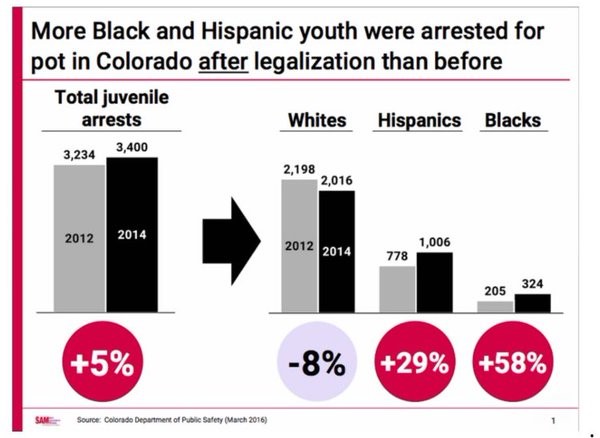
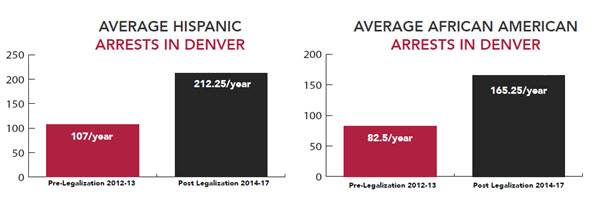
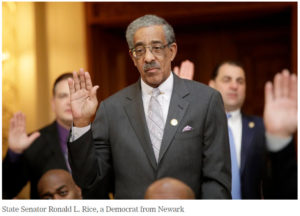 “Seeing firsthand how drugs eviscerate urban communities – and understanding how marijuana legalisation will impact the health, education, economic, business, liability and litigation complexities of our densely-populated, metropolitan-bookended state – I fully oppose it. To correct the social injustice of unfair arrests, I support decriminalising the use and possession of small amounts… When I hear my colleagues pushing for legalisation “in the name of social justice,” I can’t apologise for my instinct to suspect that it’s really about helping political friends profit from an industry that should not be allowed a foothold in our state.”
“Seeing firsthand how drugs eviscerate urban communities – and understanding how marijuana legalisation will impact the health, education, economic, business, liability and litigation complexities of our densely-populated, metropolitan-bookended state – I fully oppose it. To correct the social injustice of unfair arrests, I support decriminalising the use and possession of small amounts… When I hear my colleagues pushing for legalisation “in the name of social justice,” I can’t apologise for my instinct to suspect that it’s really about helping political friends profit from an industry that should not be allowed a foothold in our state.”